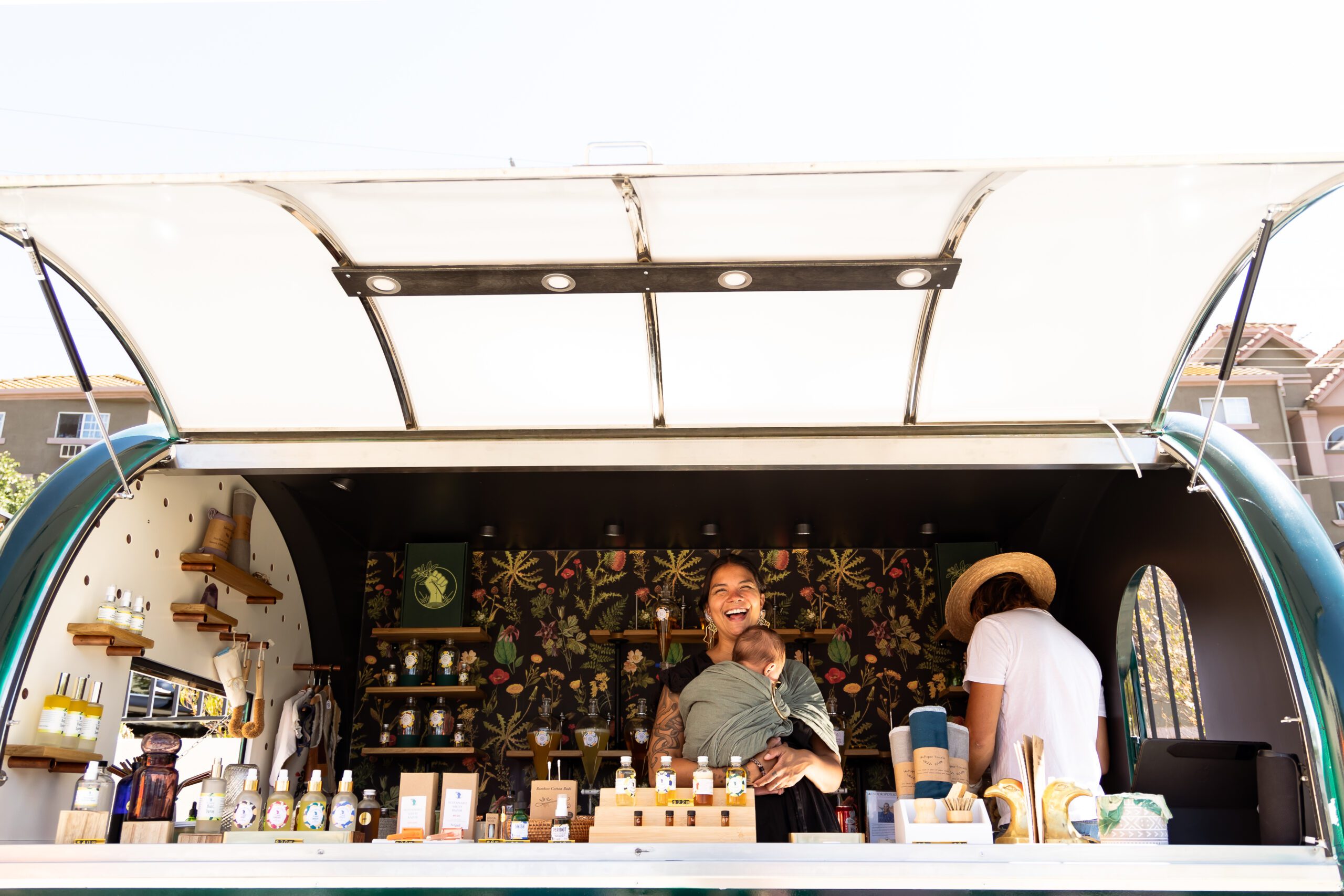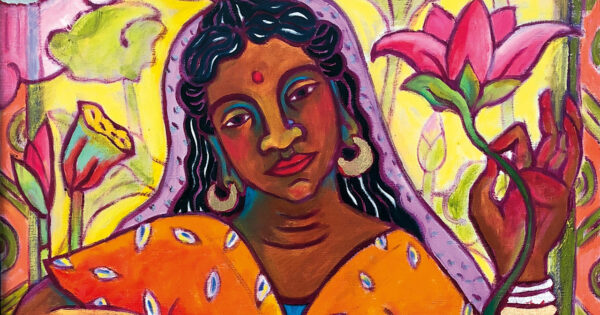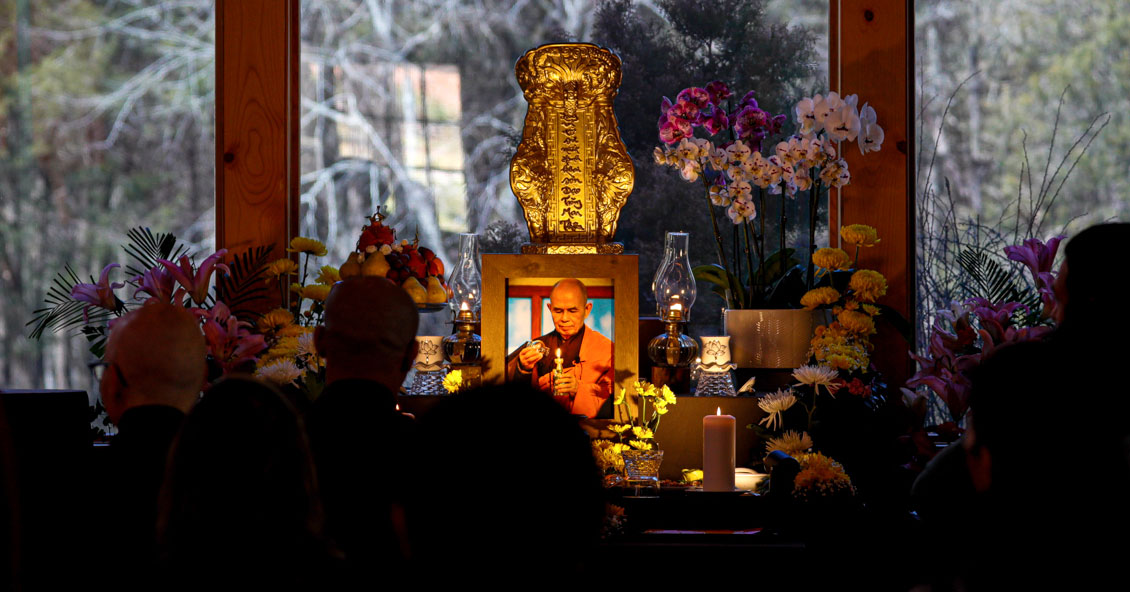“New Year, New Me” – Tết in Plum Village
Tết is the Vietnamese word for the Lunar New Year. In this article we explain some of the ways we celebrate Tết (Wrapping Earth Cakes, Flag Raising, Oracle Reading, Visiting Rooms) and nourishing joy together.
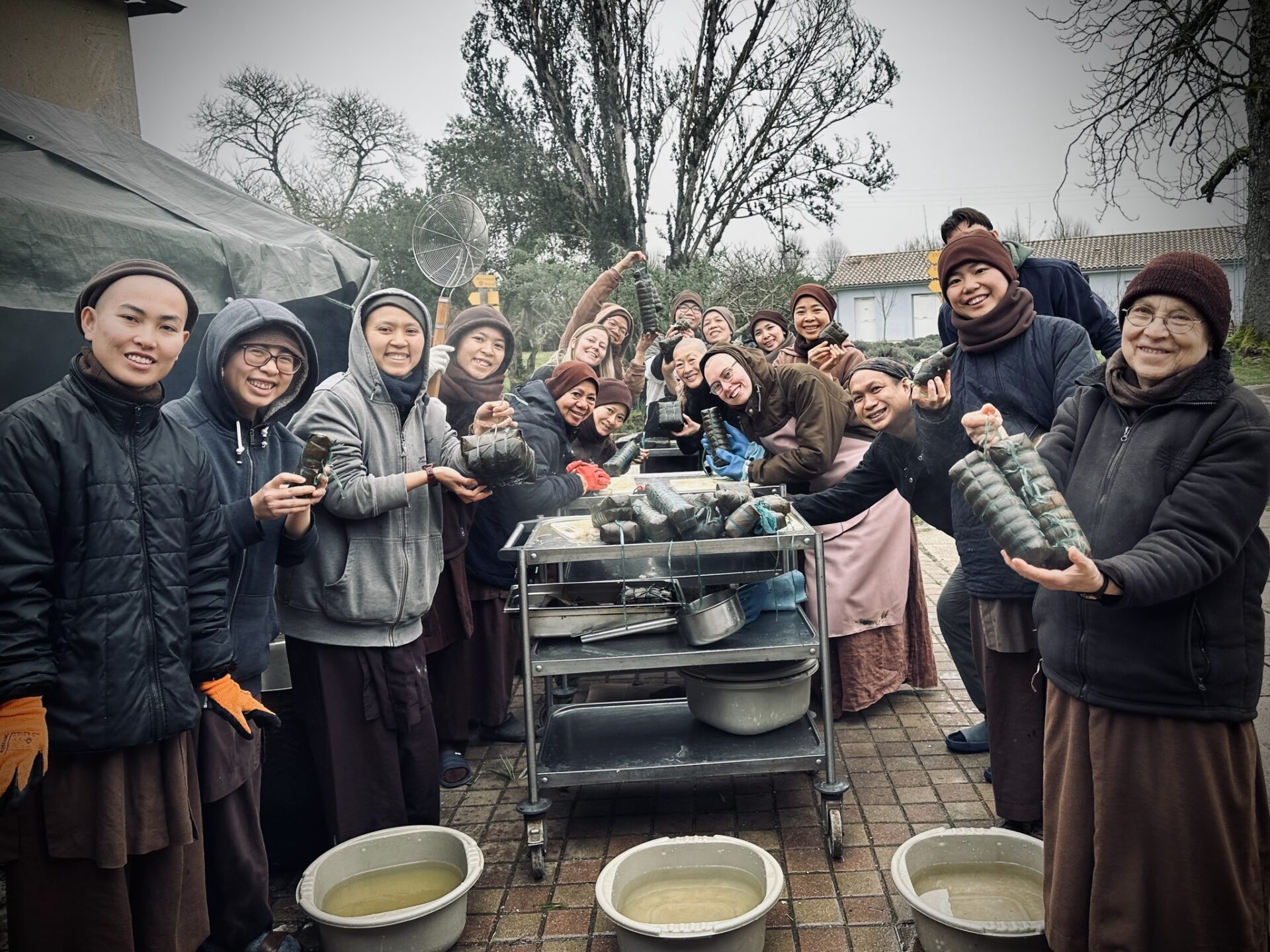
In this article, we explain some of the ways that we celebrate Tết or Lunar New Year in Plum Village. We see this occasion as a chance to deeply recognise our beloved one’s presence.
Dear friends,
At this time in Plum Village, the monastic brothers and sisters are celebrating “Tet’’ (known as Lunar New Year) as one of our traditional annual festivals. As the root of Plum Village’s practices originates from Vietnamese Buddhism, celebrating Tet in Plum Village is an opportunity to return to our genetic and spiritual ancestors, to see that these two roots inter-are.
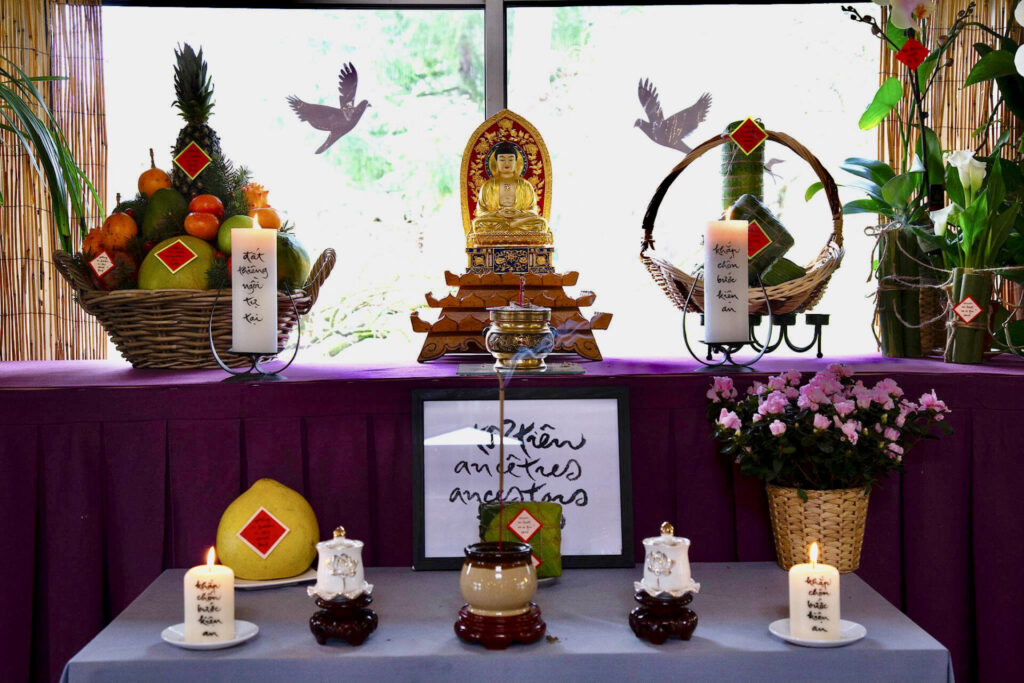
When we have realized our roots, our life is no longer in confusion and fear, we are well-protected by our genetic and spiritual ancestors.
“Tet” is a chance for us to come together, have fun with lots of youthful activities, but is also the time to be deeply aware of our beloved ones’ presence, to begin anew with ourselves and our beloved ones.
We would like to introduce Tet to you, our companions of Plum Village this beautiful and joyous festival, with different events and ceremonies; so that you can also enjoy Tet with us spiritually wherever you are.
Wrapping the Earth Cake
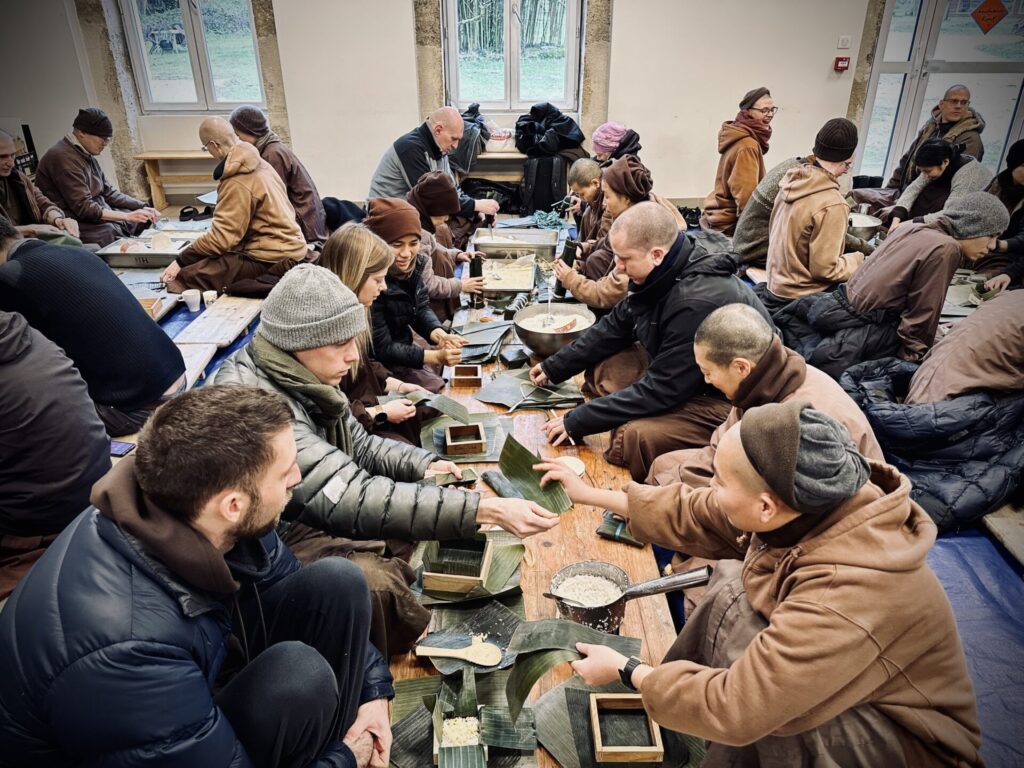 Wrapping earth cakes is a work of the entire community
Wrapping earth cakes is a work of the entire communityBrothers and sisters all gather in one hamlet to wrap the “earth cake”, a traditional Vietnamese rice cake especially made during Tet. The main ingredient is sticky rice, and the filling is made of mung beans, and it is wrapped in banana leaves. In Plum Village, the gathering for wrapping the earth cake can be very joyful and fun. We have “instant” bands and performances offered by beautiful voices in different languages, along with so many interesting Tet songs.
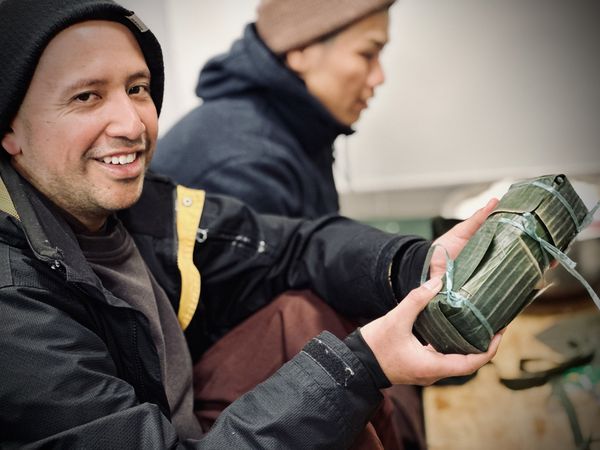
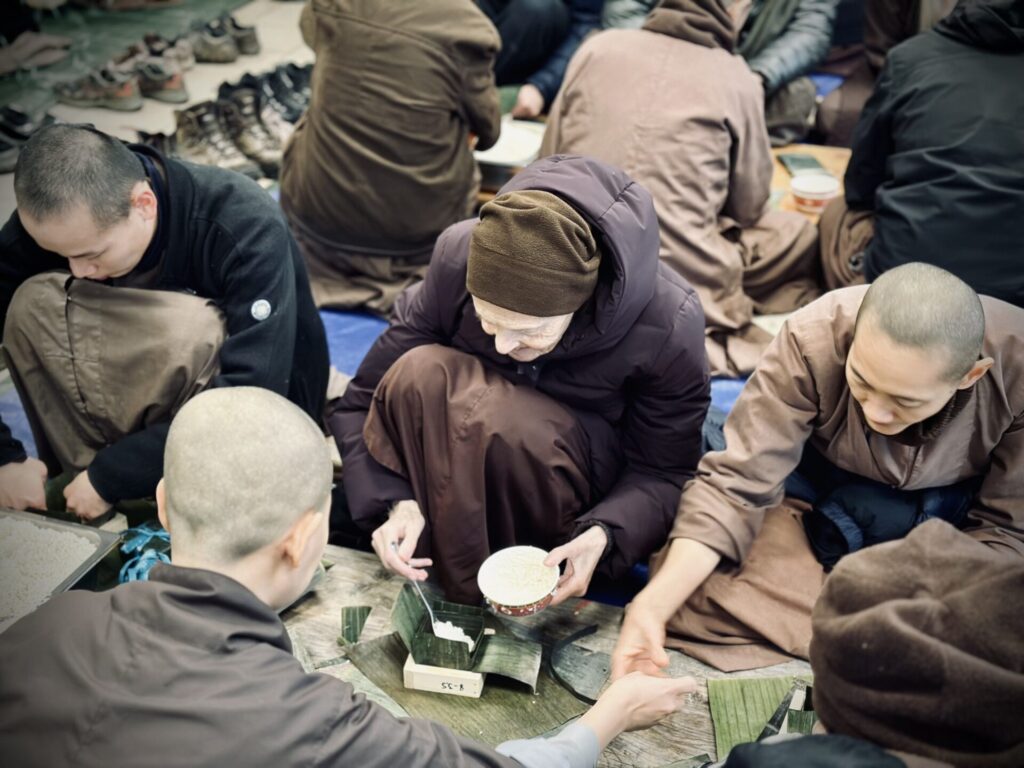
When the earth cake wrapping is done, and distributed to the 3 hamlets, it takes around 15 hours on a wood fire for the earth cake to be properly cooked. So we gather that evening around the fire to continue our endless mission of singing and telling stories. The atmosphere is very cozy and full of togetherness, brotherhood and sisterhood.
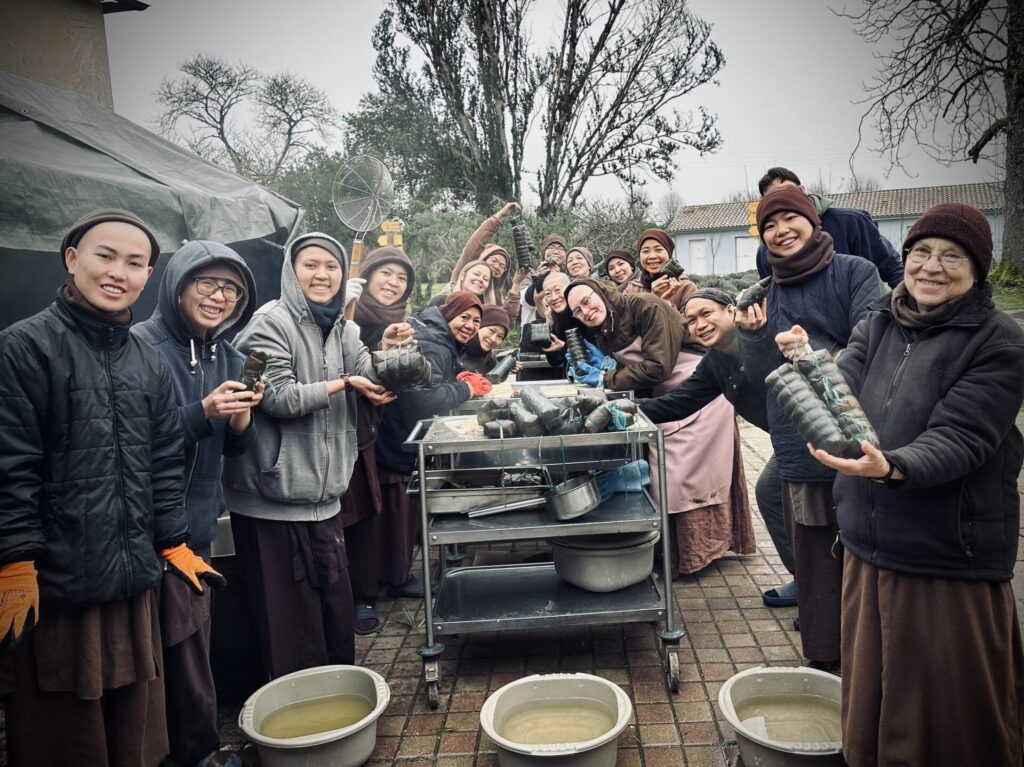 Sisters of New Hamlet working joyfully together
Sisters of New Hamlet working joyfully togetherAfter the earth cake is cooked, we choose the ones which are in the most beautiful shapes to wrap them again with fresh banana leaves, then place them on the Buddha and ancestral altars, as a way of paying respect. The rest we will treat each other during the room visit. The amount of earth cake after wrapped would be consumed enough for the year to come.

 Earth cakes are fished out one by one the next day (left) and offered on the altar (right).
Earth cakes are fished out one by one the next day (left) and offered on the altar (right).Read more about the legend of the earth cake
Kieu Oracle
The Lunar New Year, known as “Tet” in Vietnam is one of the most unusual and joyous weeks in the Plum Village calendar, with special celebrations and dharma talks, as well as informal teachings centered around the art of poetic ” Kieu oracle reading”.
A Tale of Kieu is an epic story of a beautiful and talented young woman who sells herself into marriage to save her father and brother from imprisonment. However, she did not realize that instead of marriage she was sold into prostitution, and from there, her life took many twists and turns until finally, fifteen years later she was reunited with her beloved Kim Trong – to whom she had secretly promised her hand before that fateful day.
This tale was fully written in poetic verses by a well-known writer Nguyen Du in the eighteenth century and is considered the most famous classic in Vietnamese literature. It is so well-loved and considered sacred that people have used it as an oracle to consult in important life decisions. At Plum Village, our teacher Thay has adapted this cultural art of Kieu oracle reading as a practice of spiritual guidance. It invites us to look deeply into our present situation to know how to practice so we can have more stability and happiness in the coming year. For each oracle Thay has selected lines from the poem to arrange into meaningful couplets – one line being the cause, like guidance to practice and the other line is the effect.
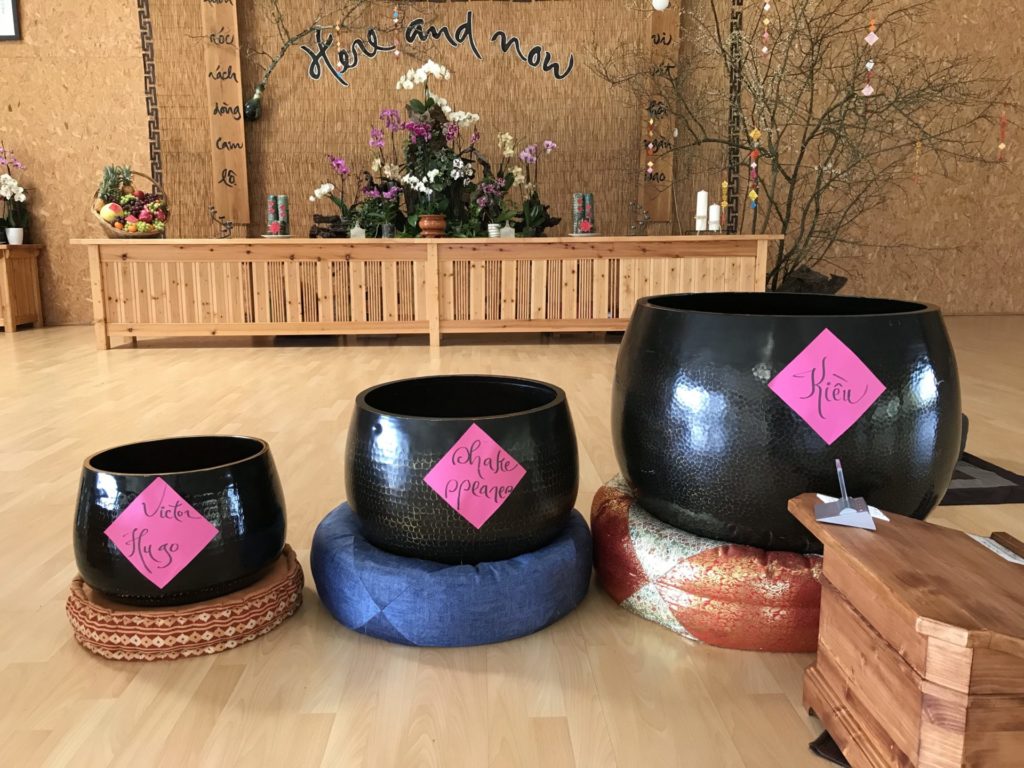 in Plum Village, You can pick an oracle from the traditional Kieu (with translation), and also from Shakespeare and Victor Hugo.
in Plum Village, You can pick an oracle from the traditional Kieu (with translation), and also from Shakespeare and Victor Hugo.Before selecting an oracle, you can return to your breath, clear your mind, and call upon the spirits of the poet, Nguyễn Du, the wise woman, đạo cô Tam Hợp, and the nun, Giác Duyên. Once you are ready, you can pose a question and pick an oracle (in red envelopes) from the bell.
The Tale of Kiều describes fifteen years of the trials and tribulations of Kiều, reflecting the poet’s life and the political environment of his time. Interestingly, the poem also mirrors the experiences of Thich Nhat Hanh (Thay) and the political upheaval during his lifetime, including the French War and the American War in Vietnam. Unlike Kiều, who was swept away by circumstance and unskillful thinking, Thay has used spiritual practice to transform suffering and realize deep wisdom and freedom. Kiều Oracle Reading is one of Thay’s precious gifts, illuminating the path of transformation and healing for generations to come.
Flag-raising Ceremony
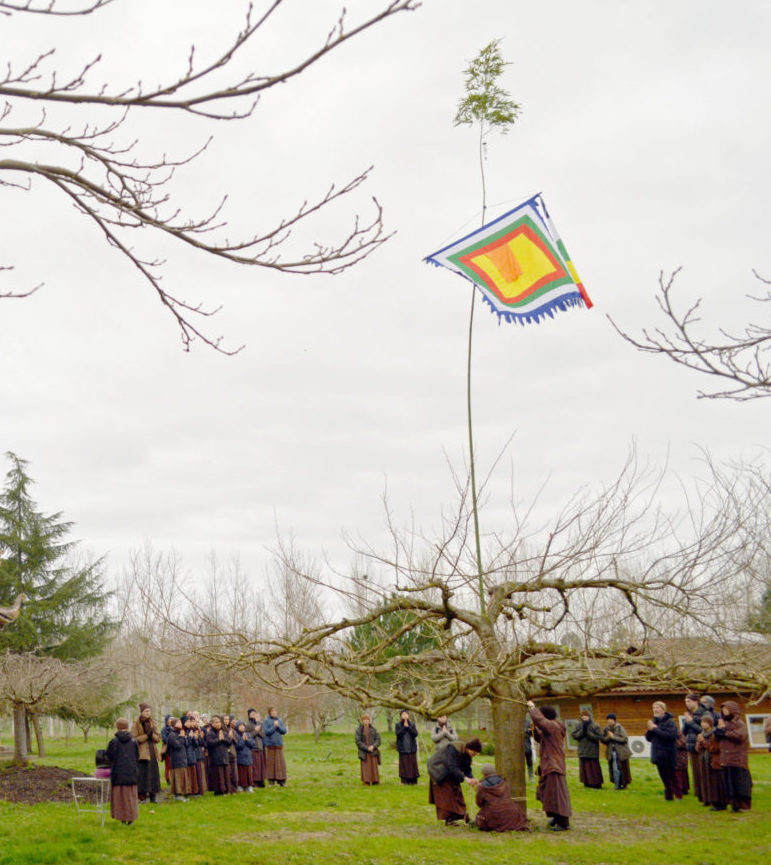
Another meaningful event of Plum Village during this period is the “flag-raising” ceremony.
The bamboo tree with the flag represents the 5 Mindfulness Trainings. It is to remind us about the practice of mindfulness in our daily lives and the way we relate to each other. If we are not mindful, if we don’t know how to speak lovingly and listen deeply, then anger, sadness, anxiety, fear, and hatred will develop in our territory and Mara (or forgetfulness) will grow.
The ceremony has the function of reminding everyone that in the new year we need to practice to reduce suffering, nourish joy and cultivate our capacity to live in harmony with each other.
Brothers and sisters will start this ceremony by gathering for a short practice of walking meditation, then assemble in a circle where a bamboo tree with a flag pinned atop is prepared in the middle of the circle. One elder in the monastic community will represent the sangha to remind us of the meaning of this ceremony. After that, the whole sangha will join our palms and do a short chanting while the bamboo is at the same time being raised. The ceremony ends with a series of the sounds of the bell as we bow to each other in the circle to offer our gratitude.
(Click here to read more about the legend of the new year tree)
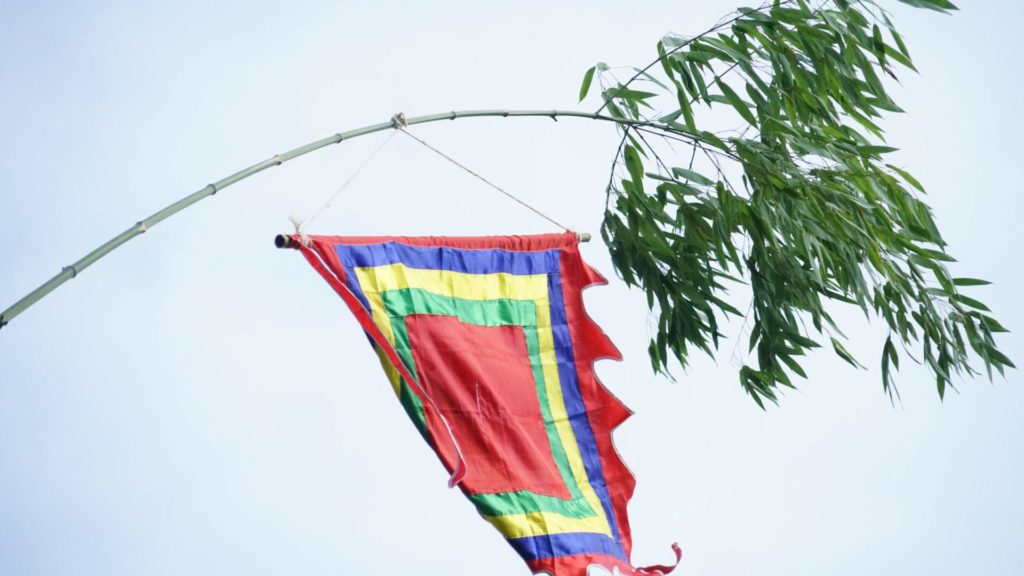 Raising the flag
Raising the flagVisiting each other
In Vietnam Tết is traditionally a time for family members from near and far to gather, celebrate togetherness, pay our respects to one another and offer well wishes for the new year. The first few days of Tết are spent visiting family and friends. The first day of Tet is particularly reserved for visiting family, especially our elders.
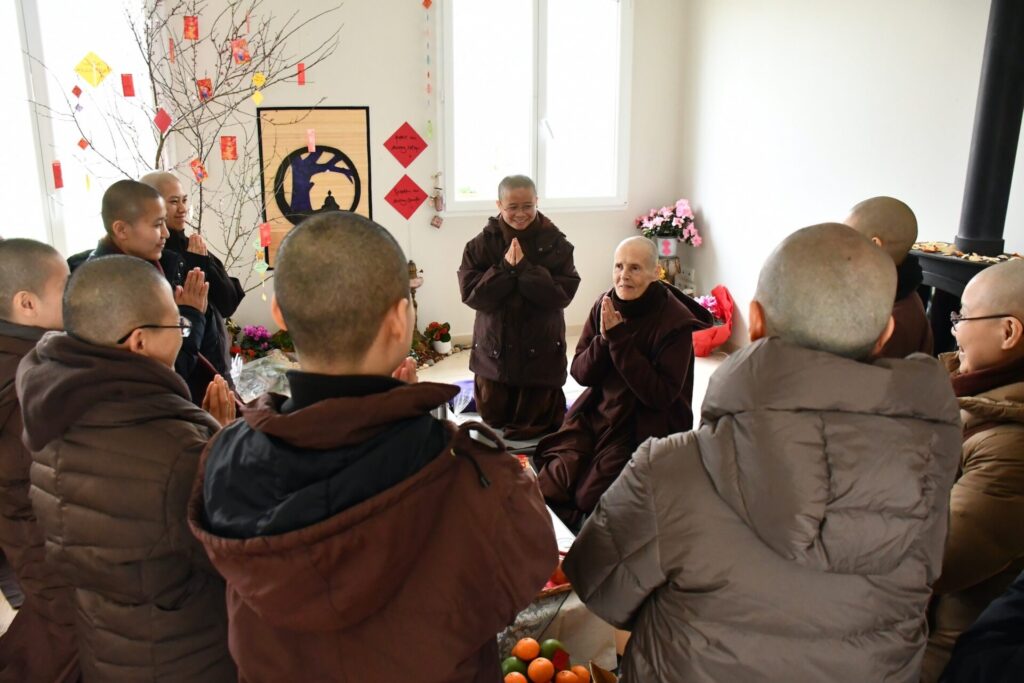 The New Hamlet sisters visiting our dear elder Sister Chan Duc
The New Hamlet sisters visiting our dear elder Sister Chan DucVisiting our elders
In Plum Village, as one large brown-clad monastic family, we spend about the first five days of Tet visiting our different hamlets. This is the only time in the year, monks, nuns and lay friends are allowed to visit each other’s residences. It is a chance for us to experience the creativity of each person in their own living space in the way she or he decorates and arranges his or her corner in the room (we share rooms!) as well as the common space in the room, which is quite interesting. It is also customary to pay our respects in each hamlet by visiting the eldest monastic, and also the abbot/abbess in their rooms. If you are lucky, you might get to hear some stories of Plum Village in the “old days”, and “bathe’’ in their wisdom.
Enjoying the food
There are typically two or more monastics living in each room, and it is customary to offer delicacies that come from our country of origin. As we are a very international family, in addition to enjoying traditional Vietnamese Tết fare, such as candied ginger, watermelon seeds, and “banh loc” (a kind of tapioca cake), one can mindfully partake in French crepes, Indonesian fried noodles, Japanese tea, Italian bruschetta, etc… as we move from room to room!
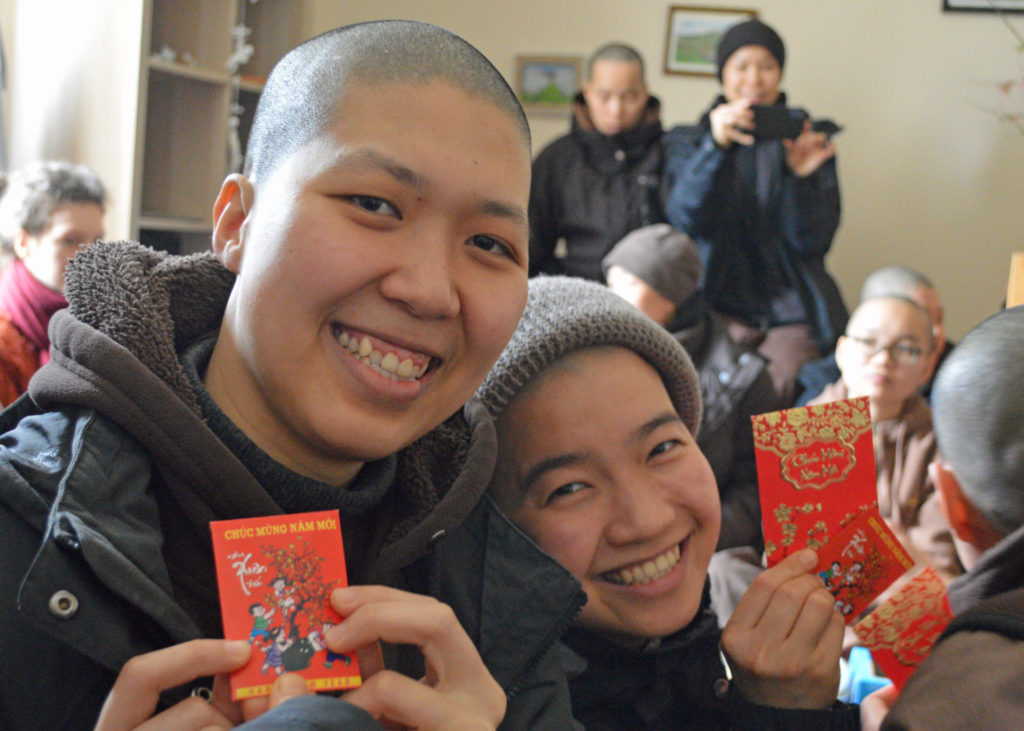 Young monastics also enjoy collecting ‘red packets’ (lucky money) from visiting their elders
Young monastics also enjoy collecting ‘red packets’ (lucky money) from visiting their eldersWell-wishes
Conversations in each room are often very lively, varied, and international. But as always, there comes a time to move on (there are so many rooms to visit!) and before leaving, it is customary to offer well-wishes to our hosts. We often wish each other good health, progress in the practice, much happiness and joy on the path and depending on how well we know each other, we may end up giving or receiving kind words of advice for our continued practice! For the more musical among us, sometimes a song will be offered as a parting gift, much to the delight of everyone else in the room.
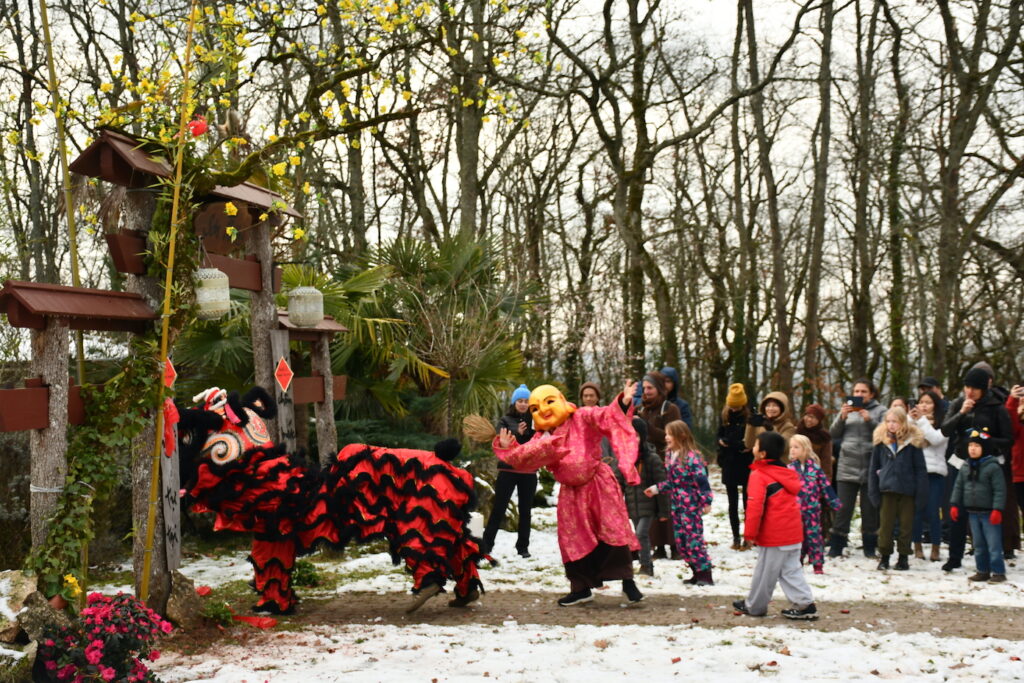 Dragon Dance
Dragon Dance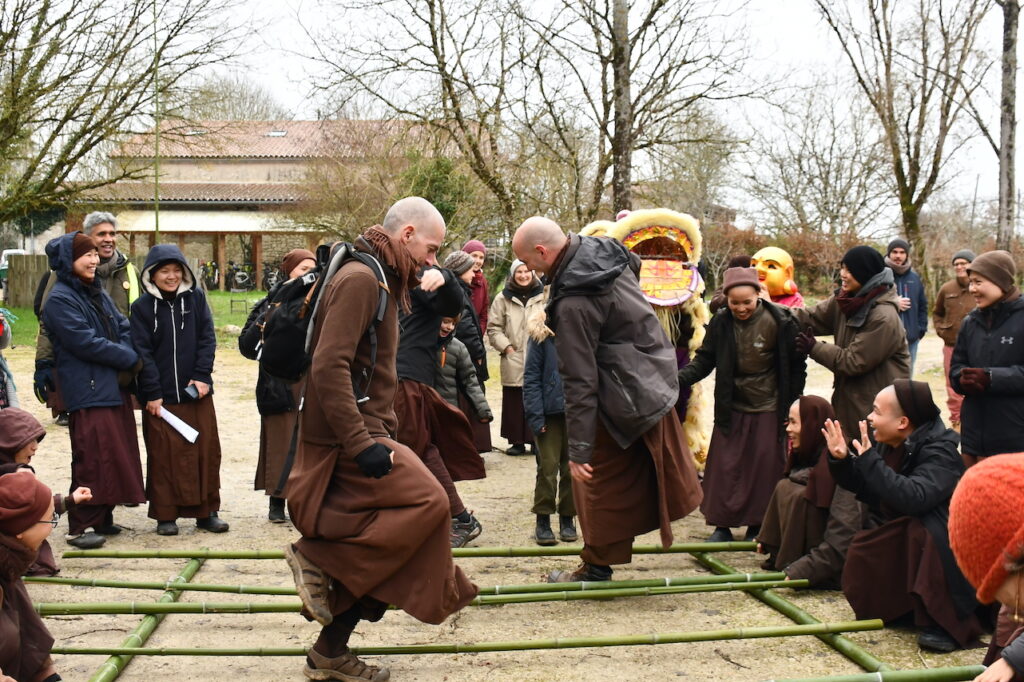 Traditional games
Traditional gamesYou might also enjoy the Parallel verses offered by the Plum Village community for the Lunar New Year.

 Fransebas
Fransebas 










